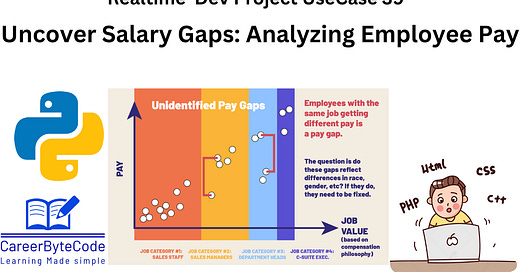Uncover Salary Gaps: Analyzing Employee Pay Using Python & Pandas
A company wants to analyze employee salaries to ensure fair compensation and detect any salary disparities between departments.
1. Context
A company wants to analyze employee salaries to ensure fair compensation and detect any salary disparities between departments. The HR team needs insights into salary distribution to make data-driven decisions regarding raises, promotions, and hiring budgets.
2. Problem Statement
The HR department needs to find the average salary for each department to determine whether certain departments are underpaid or overpaid compared to others. By grouping the data based on departments and calculating the average salary, HR can ensure fairness in salary distribution.
3. Why We Need This Use Case
In any organization, fair and competitive compensation is critical to employee satisfaction and retention. If salary disparities exist across departments, they can lead to dissatisfaction, high attrition rates, and potential legal concerns related to unequal pay.
This use case helps HR teams analyze salary data effectively, providing insights into:
Salary distribution per department – Understanding if certain departments are underpaid or overpaid.
Budget planning – Allocating funds for salary adjustments, new hires, and promotions.
Employee retention – Identifying salary gaps that may contribute to high turnover rates.
Fair compensation policies – Ensuring transparency and equality in salary distribution.
Data-driven decision-making – Avoiding biases and relying on actual data for HR strategies.
With Python and Pandas, we can automate salary analysis and generate insights quickly without relying on manual calculations.
4. When We Need This Use Case
This use case is particularly useful in the following scenarios:
Annual Salary Reviews: Before granting raises, HR needs to evaluate whether salaries are distributed fairly.
New Hiring & Budget Planning: When deciding salaries for new hires, analyzing the current salary distribution ensures competitive offers.
Pay Equity Audits: To comply with labor laws and diversity initiatives, companies must ensure equal pay across departments.
Retention & Employee Satisfaction Analysis: If employees in a specific department are leaving frequently, salary differences could be a reason.
Mergers & Acquisitions: When companies merge, aligning salary structures across teams ensures fairness and prevents dissatisfaction.
Performance & Bonus Analysis: Analyzing whether salaries align with employee performance helps in making promotion decisions.
By implementing this use case, HR teams can proactively address salary disparities before they become a major issue.






